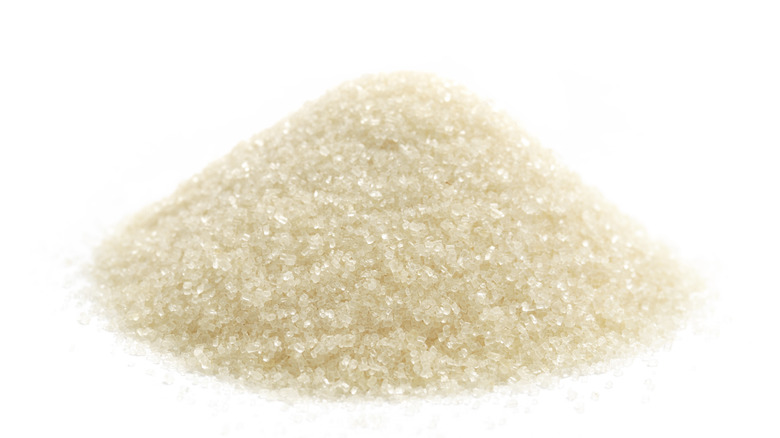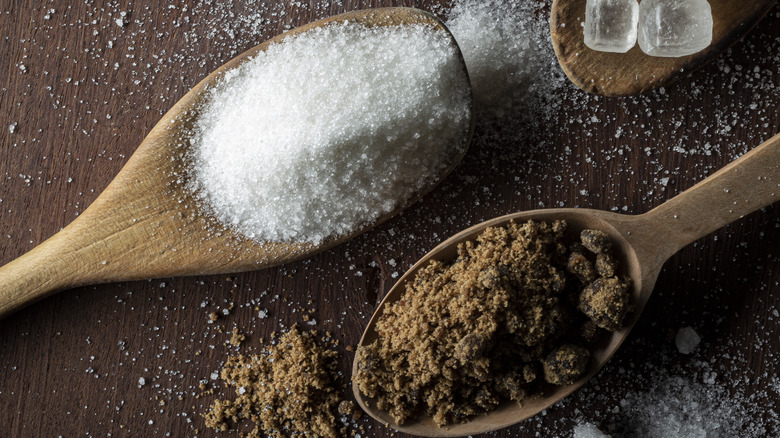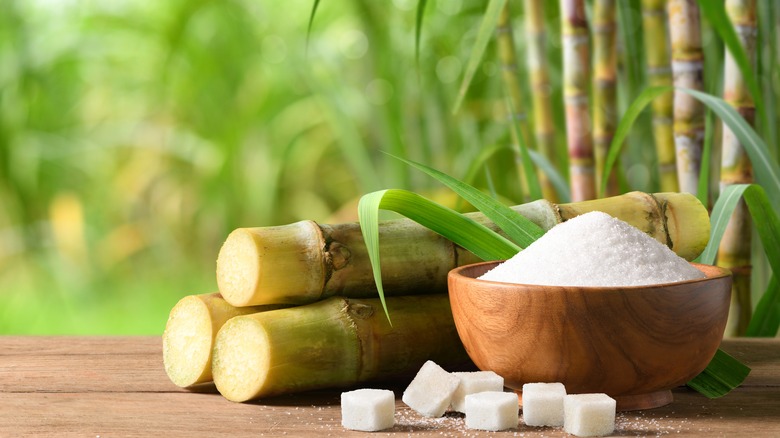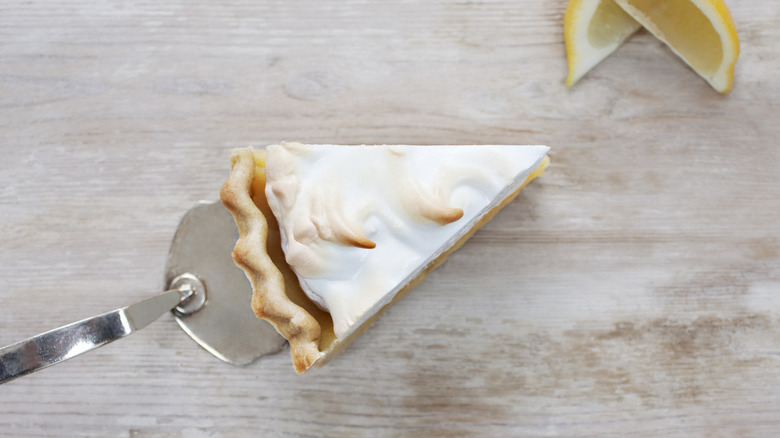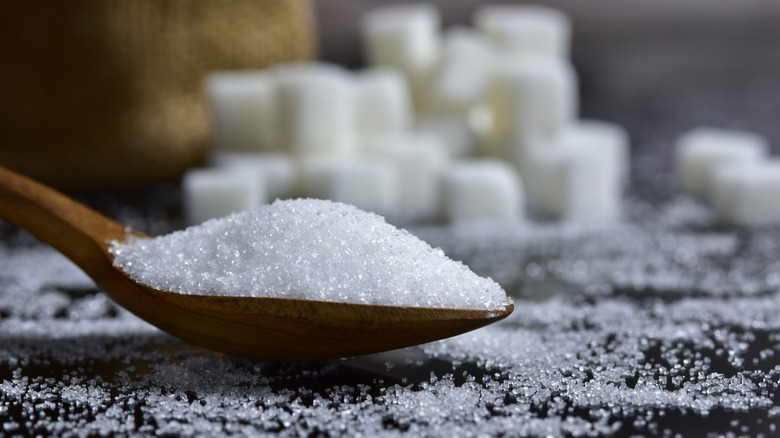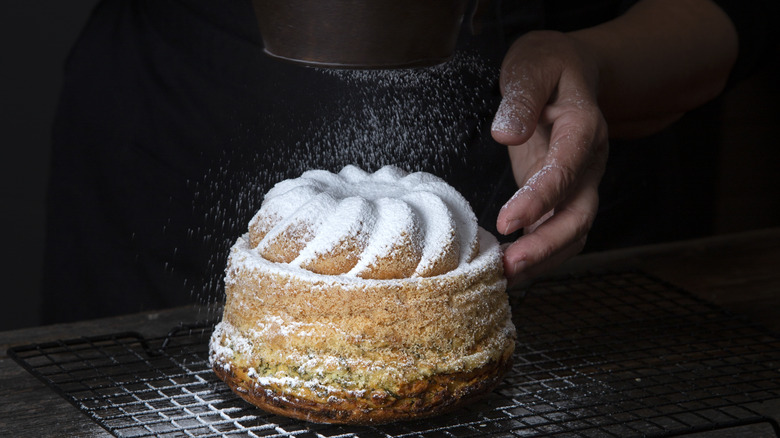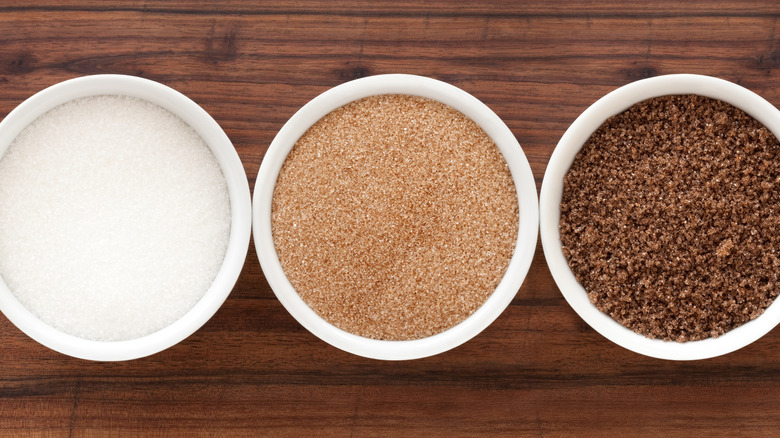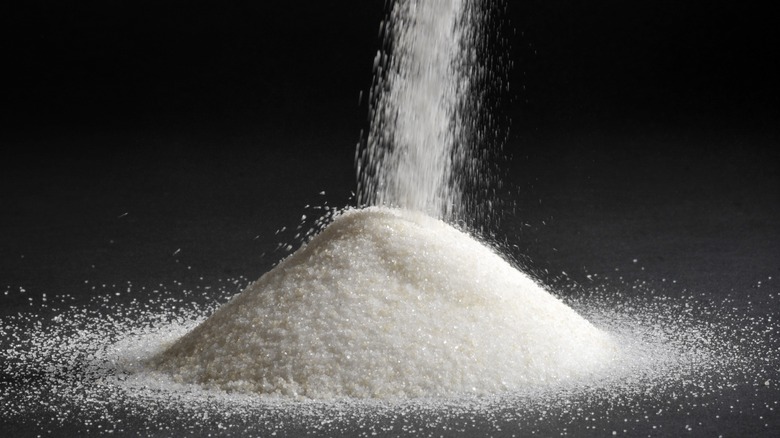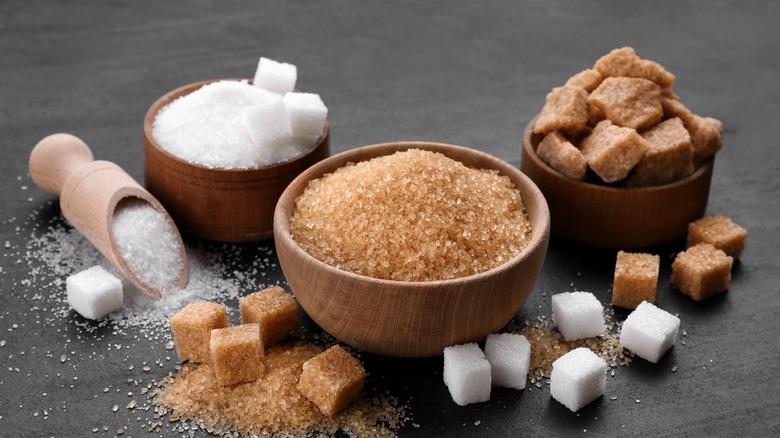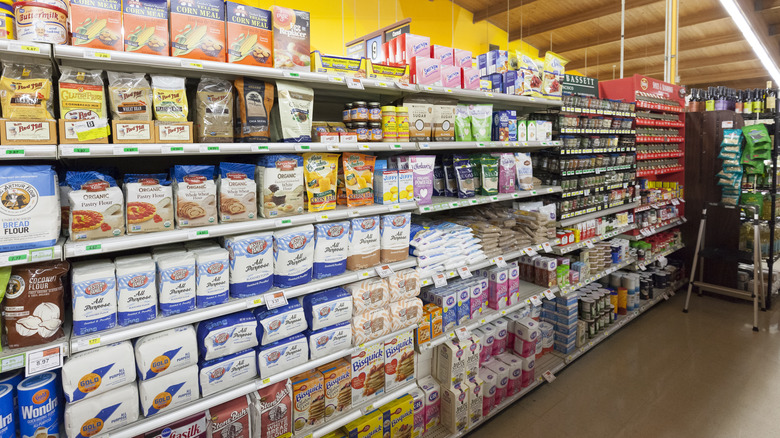What, Exactly, Is Caster Sugar?
Perhaps you have stumbled across a recipe that calls for caster sugar, and you have no idea what that is. Maybe you've simply heard it mentioned or spotted it in the grocery store or saw it in a list of ingredients at a bar and you want to know how it differs from all the other types of sugars. No matter where your confusion stems from, we are here to answer all of your caster sugar-related questions.
Caster sugar is, to put it simply, regular cane sugar that has been ground to a fine texture. Superfine sugar, casting sugar, bar sugar, castor sugar, or sometimes even baker's sugar are other words for caster sugar. The very fine texture of this sugar makes it good for certain desserts and baked goods. For example, caster sugar is regularly used for desserts whipped with egg whites because of their delicate texture. Because its fineness makes it easier to dissolve, caster sugar is also commonly used in cocktail recipes. But there's so much more to tell. Read on as we take a deep dive into all there is to know about caster sugar.
Varieties of caster sugar
One of the most complicated things about caster sugar is that there are several different varieties. The two main types of caster sugar widely available are golden caster sugar, which, like its name suggests, is golden in color, and white caster sugar, which can also be called regular caster sugar. This might make buying it a little bit confusing, especially if you don't know much about what caster sugar is in the first place.
White caster sugar looks like regular, granulated sugar, but it has a much finer texture. Golden caster sugar looks a little bit like brown sugar in color, but it has a similarly fine texture to traditional caster sugar. Golden caster sugar, which is also sometimes known as raw caster sugar, can be made either from sugar cane or beets. The main thing that sets it apart, however, is that golden caster sugar contains some molasses, which gives it a gentle caramel-esque flavor. This molasses is not added in, but rather it is already present because golden caster sugar is less refined than traditional caster sugar, meaning the molasses has not been completely taken out.
How caster sugar is produced
Caster sugar is produced much in the same way that regular white granulated sugar is produced. This means that sugar cane stalks are harvested and then sent to a sugar mill. In the sugar mill, the sugar cane is shredded and washed, then it is compressed and juiced. It is the juice from the sugar cane that is then clarified, concentrated, and then crystallized. The crystals produced through this process are known as golden raw sugar, which is a popular form of sugar for sugar packets.
The process to make granulated (or caster) sugar is not complete, however; after it is crystallized, the raw sugar is sent to a refinery to be purified and where the molasses is removed. The sugar is melted and recrystallized, after which, the sugar is officially granulated sugar. Caster sugar undergoes one extra step, wherein the crystallized sugar is blended into a fine texture, to produce the smaller grain that is necessary. One interesting aspect of caster sugar is that it can be made with beets as well as cane sugar, in a process that is very similar to how cane sugar is produced. The beets are harvested, juiced, and sugar very similar to cane sugar is then extracted from them.
Uses for caster sugar
Caster sugar may be used in the same way that granulated sugar can because it is essentially the same ingredient (with a different texture). In Australia and the U.K., for example, caster sugar is used over granulated sugar in most baking endeavors. Gordon Ramsay, the popular British celebrity chef, especially likes the ingredient. In the U.S., on the other hand, we tend to use the ingredient in a more specialized way.
There are some recipes for which caster sugar is a better option because its fine texture aids in preserving the consistency of certain desserts. In some cases, it is just easier to use. Meringues are one example where caster sugar is preferable because meringues are so delicate that it is easier for them to maintain their consistency when they are made with caster sugar. Other popular uses for caster sugar include mousses, whipped cream, cookies, and shortbreads.
The reason that caster sugar is so good for recipes like whipped cream and mousse is not only that the small granules help to preserve the delicate texture of these dishes; when the sugar granules are smaller, they also dissolve more easily. It is also for this reason that caster sugar is popular in cocktail recipes; it is a lot easier than shaking granulated sugar for the length of time it takes it to dissolve.
How it differs from granulated sugar
While granulated sugar and caster sugar are extremely similar, there are still some important differences to know. The main difference is the size of the grain. Granulated sugar is coarser; to be specific, granulated sugar grains are usually about .5 mm in diameter, whereas caster sugar grains are usually about .35 mm in diameter.
While the two are more or less interchangeable, some substitutions are easier than others. Any recipe that calls for granulated sugar, for example, can be pretty easily replaced with caster sugar. The opposite, however, is not always true; because of the fine texture of caster sugar, it is better for delicate recipes like meringues and pavlovas. You can always try your luck with granulated sugar in these situations, but you run the risk of losing out on some of that all-important texture. Caster sugar is also more likely to crystalize than granulated sugar, which makes granulated sugar better for caramel sauces and toffees.
How it differs from powdered sugar
Caster sugar is sugar made from either sugar cane or beets with a texture that is much finer than traditional granulated sugar. That sounds a lot like powdered sugar, doesn't it? These ingredients are not the same, however, and in fact have some important differences. Powdered sugar, also known as confectioner's sugar or icing sugar, is also granulated sugar that has been blended to a fine powder. However, powdered sugar is blended much more finely than caster sugar, to the point that they have extremely different textures.
Powdered sugar also contains additives to prevent it from clumping together. In the United States, powdered sugar is usually about 3-5% cornstarch. Because of this, the two ingredients are not interchangeable in most recipes. The only exception to this might be homemade powdered sugar, which does not require cornstarch if it is to be used right away. Because of the textural differences, however, it is still not a good idea to substitute these ingredients for one another.
Golden caster sugar vs. Brown sugar
Golden caster sugar, which is unrefined caster sugar that has retained some of its molasses content, sounds pretty similar to brown sugar. While the two ingredients share a lot of similarities, they are not the same thing and are not interchangeable in most recipes.
One of the biggest differences between regular brown sugar and golden caster sugar can be seen in their textures. Golden caster sugar has a loose, sandy texture. It is the same as caster sugar in all ways but one; it is unrefined. This means that it contains more molasses, which gives it more of a caramel flavor.
Light brown sugar, which is the most popular kind of soft brown sugar, has a dense, wet texture and can easily be packed down. Soft brown sugar is not only unrefined sugar, as golden caster sugar is; it also has molasses added in as an additional ingredient. Dark brown sugar is made similarly, with a higher percentage of molasses added in. Golden caster sugar can be used interchangeably with regular caster sugar, providing more of a molasses-y, caramel-y flavor, whereas brown sugar serves its own purpose in baking and cooking.
Making your own caster sugar
Since caster sugar is basically just granulated sugar that has been ground down to a fine texture, it is pretty simple to make at home. All that you need is granulated sugar and some kind of grinding or blending device. This could be a coffee grinder, a spice grinder, a food processor, or a blender.
All you need to do is add your sugar to your chosen blending device, making sure to add enough sugar to cover the blades (because of this, smaller spice grinders might be best if you just want to make a small batch). After you have done this, the only remaining step is to pulse your sugar until it reaches a very fine consistency. Make sure you don't blend your sugar too much, however, because if you do, you might go past the point of caster sugar and end up with powdered sugar. Because caster sugar can be rather difficult to find in the United States, this easy and handy trick is good to know.
Substitutes for caster sugar
While caster sugar serves its purpose in the world of baking, that does not mean that there aren't suitable substitutes for when you don't have any caster sugar on hand. Of course, the best substitute for when you can't find caster sugar in the store would be to make your own by blending granulated sugar in a blender or spice grinder. If you can't do that either, however, here is a rough substitution guide to follow.
For cakes and cookies, granulated sugar is a perfectly acceptable substitute. To maintain the same texture that caster sugar would provide, you can use butter that is slightly colder than room temperature and beat the sugar and butter together for longer. For cocktails, granulated sugar also works just fine; you will just have to shake or stir your cocktail for longer because the sugar will dissolve more slowly. In recipes for meringues or angel food cake, where you have to beat sugar and egg whites together, you can use granulated sugar as well. One tip to make the granulated sugar work better is to mix more slowly, because this allows the sugar to melt more effectively.
When substituting, it is also important to remember that a cup of caster sugar and a cup of granulated sugar are not the same thing. One cup of granulated sugar is 220 grams, whereas a cup of caster sugar is 225 grams, which is why it is best to measure by weight.
Where to buy caster sugar in store and online
While caster sugar is a very popular ingredient in places like the U.K. and Australia (possibly even more popular than regular granulated sugar), in the United States, the ingredient can be rather challenging to come by. Some grocery stores may carry caster sugar, but many people will likely have to visit a specialty grocery store. If that is too much work, or if you don't have a specialty baking store that carries caster sugar nearby, you can also easily order the ingredient online.
Depending on how much caster sugar you need, anything from a small 11.25-ounce package of Judee's superfine caster sugar to a 12-pound container of C&H caster sugar (though this latter option is likely best for avid and professional bakers). Additionally, while caster sugar is not readily available at stores such as Walmart, these chains sometimes allow you to order the ingredient for delivery.
